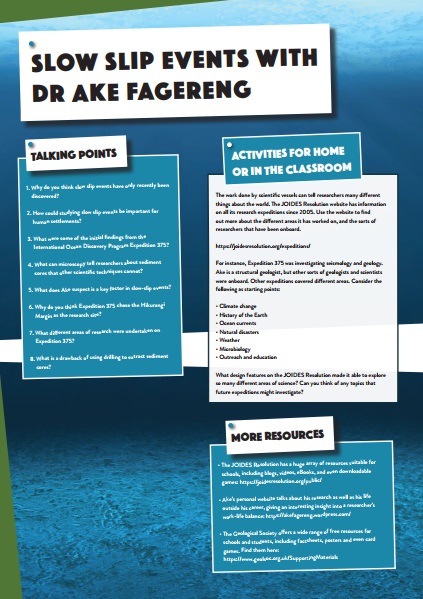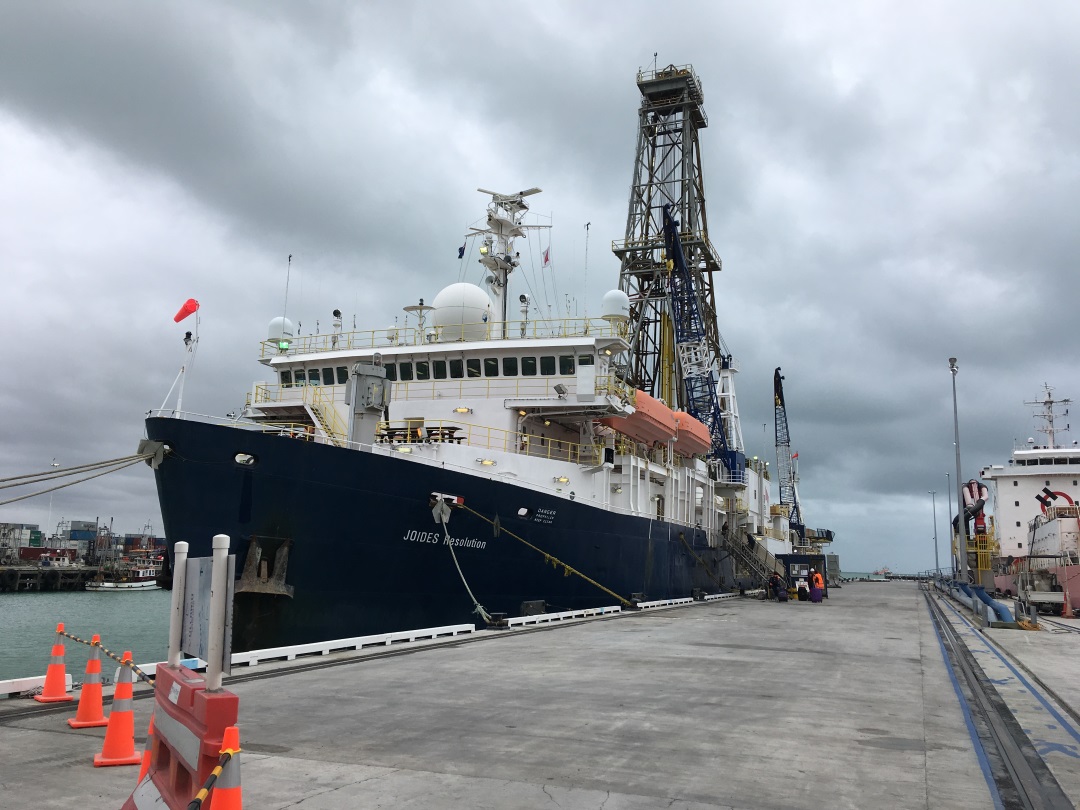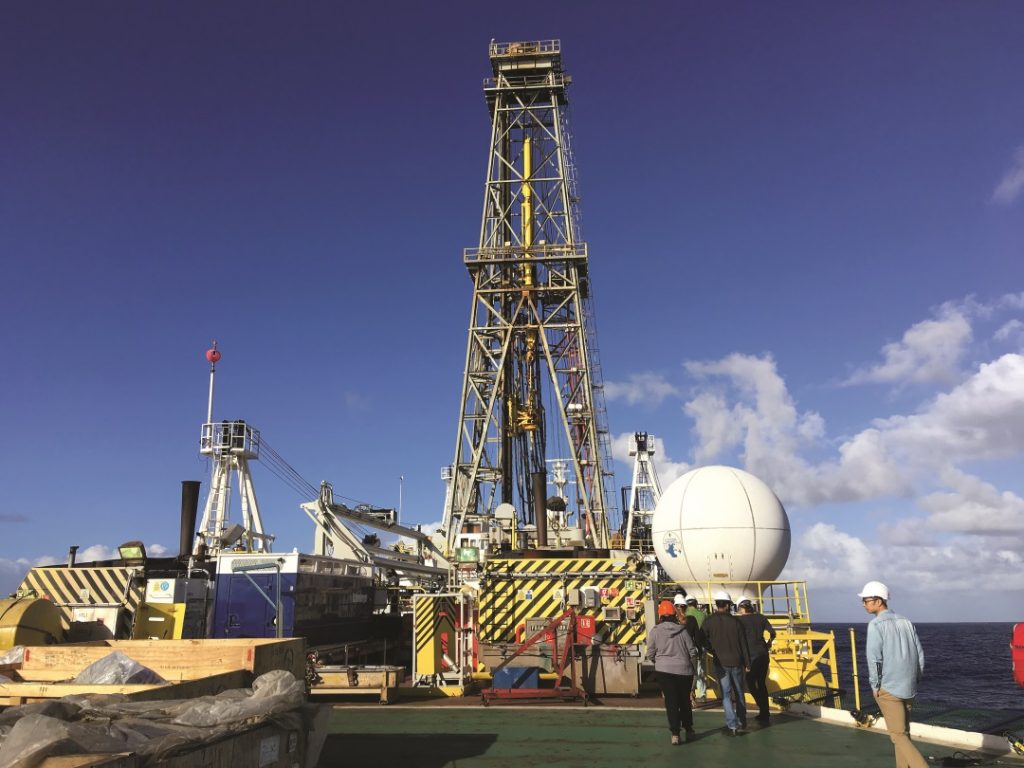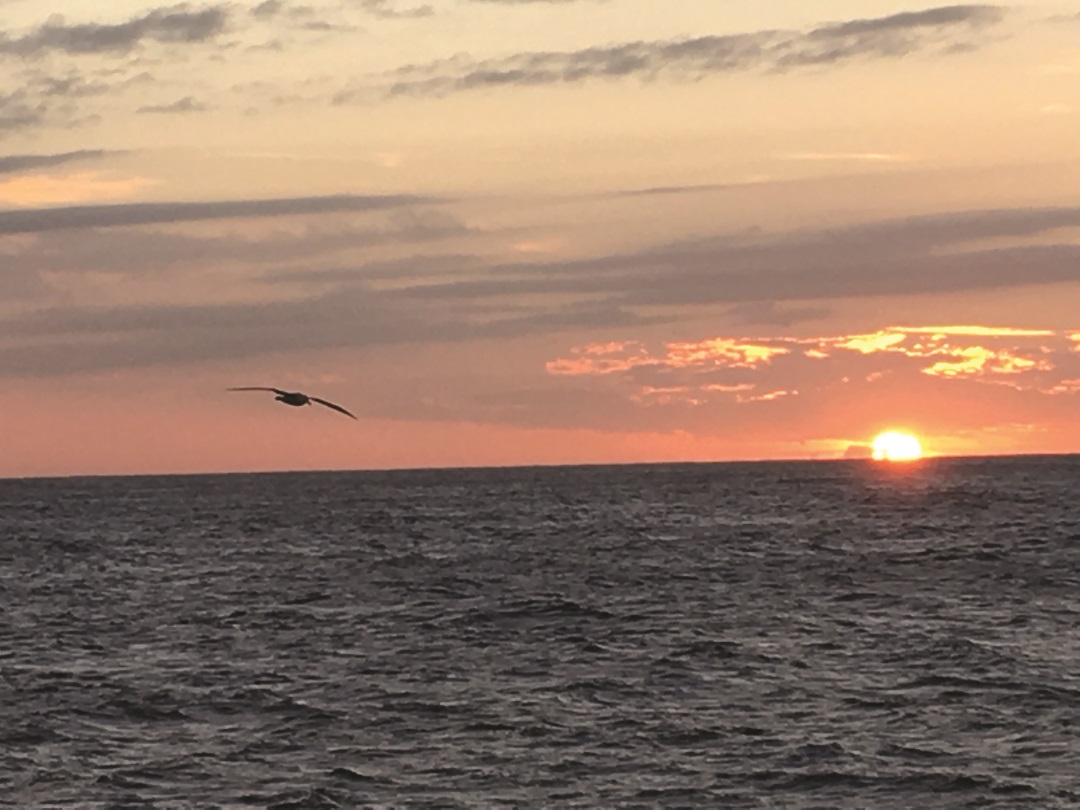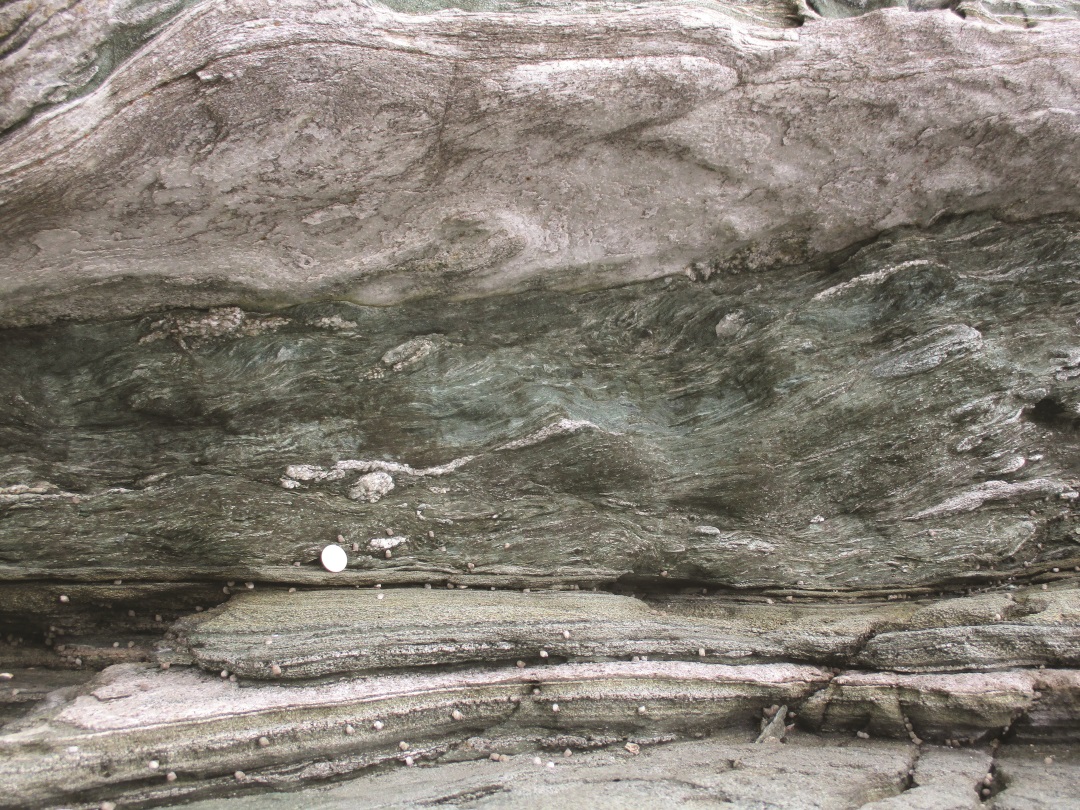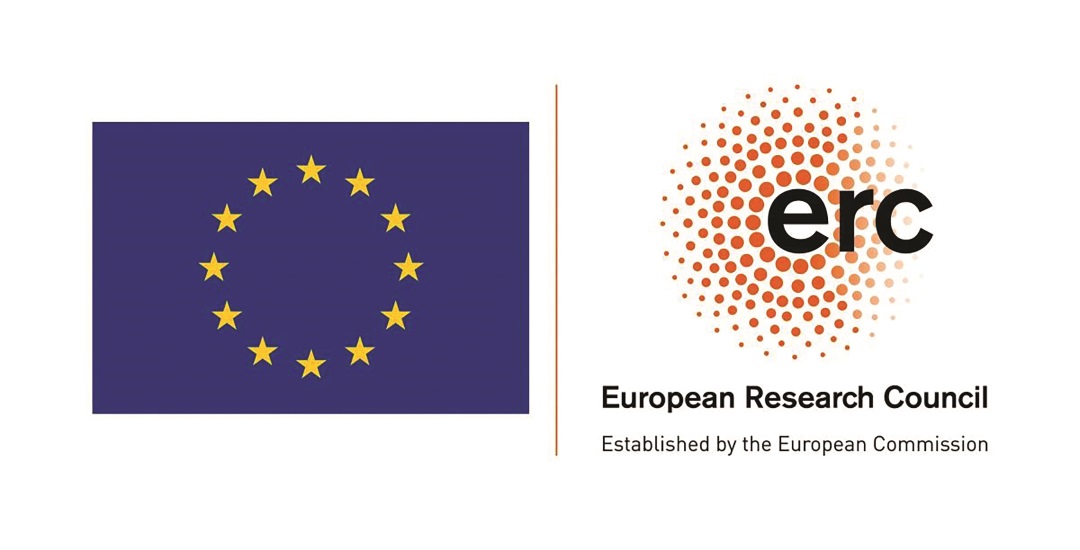Taking to the seas to discover how the Earth’s surface moves
Earthquakes are known for being dramatic and even catastrophic, but they are not the only way that the Earth moves. Slow slip events are much more low-profile and understanding more about them could improve earthquake forecasting. Dr Ake Fagereng of Cardiff University went on a voyage of discovery to find out more about these ‘silent earthquakes’
There is much we have yet to discover about the events that shape the planet we live on. It is only in recent decades that researchers have found out about slow slip events – ‘slow motion’ earthquakes that cannot be detected by seismic equipment. Dr Ake Fagereng, of Cardiff University’s School of Earth and Ocean Sciences, has made a career out of travelling the world to uncover how and why these events occur.
A recent expedition (Expedition 375) saw him spending two months on a ship called JOIDES Resolution, drilling into the seabed off New Zealand and examining the sediment cores that the team on board the ship had extracted.
WHAT IS THE DIFFERENCE BETWEEN SLOW SLIP EVENTS AND EARTHQUAKES?
The Earth’s surface is always moving. The crust of the Earth is made up of rigid tectonic plates that float on solid but slow flowing mantle. The area where two different plates meet is known as a fault plane, and is where tectonic events like slow slip events and earthquakes most commonly happen. Although slow slip events are relatively fast on the geological timescale, they are too slow to be detected by seismometers, the equipment typically used to detect ground movement caused by earthquakes. They are instead detected by GPS devices, essentially the same technology found in Sat Navs and map apps. If the distance between two points is found to have significantly changed over time, chances are that a slow slip event has occurred.
Earthquakes happen at a much faster rate. “Instead of motion occurring steadily, the faults store elastic energy until they suddenly release it all at once,” explains Ake. “Think of pulling on a stuck door until it suddenly opens.” It is this rapid release of pent-up energy that can cause such catastrophic damage to communities on the Earth’s surface.
WHAT IS SO INTERESTING ABOUT SLOW SLIP EVENTS?
“My interest is driven by exploration of the unknown,” says Ake. First discovered on the famous San Andreas fault in California, evidence of slow slip events was only found in other places across the world in the last couple of decades. “Although we are rapidly advancing our understanding, there is still much to learn,” says Ake. There is also the possibility of a practical application, one that could even save lives. “In the short amount of time we have known about slow slip events, there are a few examples happening immediately before earthquakes,” says Ake. “Understanding them may help us towards improved forecasting of major earthquakes.”
As well as potentially predicting when earthquakes might happen, knowing about these events could also help researchers predict where earthquakes might strike. “Slow slip events and the accumulation of elastic energy that leads to earthquakes happen in the same or neighbouring areas,” says Ake. It is difficult to detect this energy build-up, but GPS can detect slow slip events – so outlining where slow slip events are occurring could give scientists an idea of where earthquakes are likely to strike, and even how dramatic any future earthquakes are likely to be.
WHAT HAVE BEEN THE FINDINGS FROM THE NEW ZEALAND EXPEDITION?
Although lots of the results are still pending, there have already been some key findings from the expedition. “One fault zone we sampled contained lots of different rock structures,” says Ake. “This might mean that a range of slip speeds are possible in the same place. This means that slow slip events could happen alongside, and even play some part in, more major earthquakes.” The ocean floor at the study site had lots of different sediment types, which Ake and his colleagues think might lead to a large range of slip styles. To see how the faults change over time, the team set up observatories (sensory equipment measuring parameters such as temperature and pressure) in the boreholes left over from the drilling, that they hope will give them further insights.
WHAT ROLE DO MICROSCOPES HAVE IN THIS RESEARCH?
Scanning electron microscopy (SEM) allows researchers to examine tiny details in rock samples, even as small as 10 nanometres. Researchers can investigate how faults developed through samples, for instance whether they followed boundaries between different materials (such as grains of sand or silt) in the rock, or if they fractured through these materials. “We can also use SEM to find evidence of past earthquakes,” says Ake. “We look for structures resulting from increased heat, which is produced by the friction generated in a fast slip event.”
WHAT HAVE EXPEDITIONS INTO OTHER AREAS OF THE WORLD TAUGHT RESEARCHERS?
Ake has undertaken research in Japan, Namibia, Cyprus and the UK, all places thought to have experienced slow slip events in the distant past. “We don’t know the tell-tale signs of a slow slip event for certain yet, but this is one of the things we hope to work out,” says Ake. The researchers have found a few common features at the study sites, which are potentially linked to slow slip events. “In all locations we have found evidence for the presence of water along the faults when they were active, which is known to weaken them and make them more likely to slip,” says Ake. These weak faults don’t necessarily lead to earthquakes, if they are surrounded by rocks that stop cracks accelerating. Understanding these complex relationships and interactions between all the different rock types could be key to discovering the causes of slow slip events, and how they link to large earthquakes.
EXPEDITION 375: KEY FACTS
• Research Vessel: JOIDES Resolution, named after Captain Cook’s HMS Resolution
• Location: Hikurangi Margin, a fault off the east coast of New Zealand’s North Island, where the Pacific and Australian tectonic plates meet
• Objective: collect core samples by drilling into the ocean floor, and study them to better understand the geology behind slow slip events
• Vessel Features:
– Drill can reach a depth of up to six miles (although it rarely goes beyond a mile below the seafloor)
– Capacity of up to 50 scientists and technicians, and 65 crew members
– Began scientific drilling work in 1985, and was completely retrofitted in 2006-2008
 DR AKE FAGERENG
DR AKE FAGERENG
Reader in Structural Geology
School of Earth and Ocean Sciences
Cardiff University, UK
FIELD OF RESEARCH: Geology
RESEARCH PROJECT: Using mouse models to investigate the causes and potential treatments of two rare diseases that affect the kidneys.
FUNDERS: European Research Council (ERC) Horizon 2020 (starting-grant 715836 “MICA”), International Ocean Discovery Program (IODP), United Kingdom Research and Innovation (UKRI), Natural Environment Research Council (NERC)
Reference
https://doi.org/10.33424/FUTURUM44
There is much we have yet to discover about the events that shape the planet we live on. It is only in recent decades that researchers have found out about slow slip events – ‘slow motion’ earthquakes that cannot be detected by seismic equipment. Dr Ake Fagereng, of Cardiff University’s School of Earth and Ocean Sciences, has made a career out of travelling the world to uncover how and why these events occur.
A recent expedition (Expedition 375) saw him spending two months on a ship called JOIDES Resolution, drilling into the seabed off New Zealand and examining the sediment cores that the team on board the ship had extracted.
WHAT IS THE DIFFERENCE BETWEEN SLOW SLIP EVENTS AND EARTHQUAKES?
The Earth’s surface is always moving. The crust of the Earth is made up of rigid tectonic plates that float on solid but slow flowing mantle. The area where two different plates meet is known as a fault plane, and is where tectonic events like slow slip events and earthquakes most commonly happen. Although slow slip events are relatively fast on the geological timescale, they are too slow to be detected by seismometers, the equipment typically used to detect ground movement caused by earthquakes. They are instead detected by GPS devices, essentially the same technology found in Sat Navs and map apps. If the distance between two points is found to have significantly changed over time, chances are that a slow slip event has occurred.
Earthquakes happen at a much faster rate. “Instead of motion occurring steadily, the faults store elastic energy until they suddenly release it all at once,” explains Ake. “Think of pulling on a stuck door until it suddenly opens.” It is this rapid release of pent-up energy that can cause such catastrophic damage to communities on the Earth’s surface.
WHAT IS SO INTERESTING ABOUT SLOW SLIP EVENTS?
“My interest is driven by exploration of the unknown,” says Ake. First discovered on the famous San Andreas fault in California, evidence of slow slip events was only found in other places across the world in the last couple of decades. “Although we are rapidly advancing our understanding, there is still much to learn,” says Ake. There is also the possibility of a practical application, one that could even save lives. “In the short amount of time we have known about slow slip events, there are a few examples happening immediately before earthquakes,” says Ake. “Understanding them may help us towards improved forecasting of major earthquakes.”
As well as potentially predicting when earthquakes might happen, knowing about these events could also help researchers predict where earthquakes might strike. “Slow slip events and the accumulation of elastic energy that leads to earthquakes happen in the same or neighbouring areas,” says Ake. It is difficult to detect this energy build-up, but GPS can detect slow slip events – so outlining where slow slip events are occurring could give scientists an idea of where earthquakes are likely to strike, and even how dramatic any future earthquakes are likely to be.
WHAT HAVE BEEN THE FINDINGS FROM THE NEW ZEALAND EXPEDITION?
Although lots of the results are still pending, there have already been some key findings from the expedition. “One fault zone we sampled contained lots of different rock structures,” says Ake. “This might mean that a range of slip speeds are possible in the same place. This means that slow slip events could happen alongside, and even play some part in, more major earthquakes.” The ocean floor at the study site had lots of different sediment types, which Ake and his colleagues think might lead to a large range of slip styles. To see how the faults change over time, the team set up observatories (sensory equipment measuring parameters such as temperature and pressure) in the boreholes left over from the drilling, that they hope will give them further insights.
WHAT ROLE DO MICROSCOPES HAVE IN THIS RESEARCH?
Scanning electron microscopy (SEM) allows researchers to examine tiny details in rock samples, even as small as 10 nanometres. Researchers can investigate how faults developed through samples, for instance whether they followed boundaries between different materials (such as grains of sand or silt) in the rock, or if they fractured through these materials. “We can also use SEM to find evidence of past earthquakes,” says Ake. “We look for structures resulting from increased heat, which is produced by the friction generated in a fast slip event.”
WHAT HAVE EXPEDITIONS INTO OTHER AREAS OF THE WORLD TAUGHT RESEARCHERS?
Ake has undertaken research in Japan, Namibia, Cyprus and the UK, all places thought to have experienced slow slip events in the distant past. “We don’t know the tell-tale signs of a slow slip event for certain yet, but this is one of the things we hope to work out,” says Ake. The researchers have found a few common features at the study sites, which are potentially linked to slow slip events. “In all locations we have found evidence for the presence of water along the faults when they were active, which is known to weaken them and make them more likely to slip,” says Ake. These weak faults don’t necessarily lead to earthquakes, if they are surrounded by rocks that stop cracks accelerating. Understanding these complex relationships and interactions between all the different rock types could be key to discovering the causes of slow slip events, and how they link to large earthquakes.
EXPEDITION 375: KEY FACTS
• Research Vessel: JOIDES Resolution, named after Captain Cook’s HMS Resolution
• Location: Hikurangi Margin, a fault off the east coast of New Zealand’s North Island, where the Pacific and Australian tectonic plates meet
• Objective: collect core samples by drilling into the ocean floor, and study them to better understand the geology behind slow slip events
• Vessel Features:
– Drill can reach a depth of up to six miles (although it rarely goes beyond a mile below the seafloor)
– Capacity of up to 50 scientists and technicians, and 65 crew members
– Began scientific drilling work in 1985, and was completely retrofitted in 2006-2008
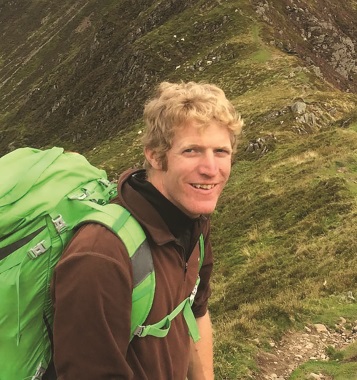 DR AKE FAGERENG
DR AKE FAGERENG
Reader in Structural Geology
School of Earth and Ocean Sciences
Cardiff University, UK
FIELD OF RESEARCH: Geology
RESEARCH PROJECT: Using mouse models to investigate the causes and potential treatments of two rare diseases that affect the kidneys.
FUNDERS: European Research Council (ERC) Horizon 2020 (starting-grant 715836 “MICA”), International Ocean Discovery Program (IODP), United Kingdom Research and Innovation (UKRI), Natural Environment Research Council (NERC)
ABOUT EXPEDITION 375
In March 2018, the research vessel JOIDES Resolution set out for a two-month voyage off the coast of New Zealand’s North Island. The team aboard was planning to extract drill cores from a fault plane not far offshore, where the world’s shallowest slow slip events are believed to happen. The aim was to use a variety of research techniques to discover the processes and conditions that lead to slow slip events. Ake joined the team as a structural geologist.
WHAT SKILLS DID AKE BRING TO THE TEAM?
“My main job was describing the structures in the sediment cores that the drills extracted. This included fractures, faults and layers,” says Ake. “I had little previous experience of working with sediment cores from the seabed but had lots of experience describing similar structures on land.” A sediment core is extracted using a long drill that digs deep into the seabed and looks like a long cylindrical structure only a few centimetres in diameter. “Having experience from on-land studies helped me to quickly learn how to deal with this sort of sample,” says Ake.
WHAT DID A TYPICAL DAY LOOK LIKE?
“The expedition scientists work 12-hour shifts, either noon to midnight or midnight to noon,” says Ake. “I was on the day shift, so usually woke up mid-morning. I shared my cabin with a researcher who worked the night shift, so we hardly ever saw each other.”
“I would get up ahead of my shift, go to the gym to make sure I got some exercise, and grab some food. The shift always began with a quick update from the night shift team, and then we take over,” says Ake. “What happens during the shift varies a lot. When drilling is taking place, it’s a game of balancing speed against detail, to work through describing the material coming in without building up much of a backlog. Other teams describe different aspects of the sediments, such as density, porosity or magnetic properties, so we have to coordinate to make sure we don’t hold each other up.”
The ship isn’t collecting samples full-time, which means there is a variety of work onboard. “There are breaks in coring, when we’re installing borehole observatories or moving between sites. We use this time to catch up on backlogs or write reports. In my down time, such as after a shift, I would check my emails, then maybe watch a movie, play a board game or read a book. Then I would catch some sleep and repeat the next day.”
WHAT CHALLENGES DID AKE FACE DURING THE EXPEDITION?
“Drilling causes deformation in the cores,” says Ake. “It can be tricky to tell what structures in the samples are caused by tectonic deformation, and which are caused by sample extraction. From past experience we have learned how to separate the two, but uncertainty always remains. We make sure to remember this when we report on our findings.”
Life at sea also inevitably has its drawbacks. “Being away from home for two months is challenging, and we lived in a very small community: about thirty scientists and seventy technicians and crew,” says Ake. “And all in very limited space!”
WHAT WERE AKE’S PERSONAL HIGHLIGHTS FROM THE EXPEDITION?
“It’s very rare to have such a varied team working on the same problem,” says Ake. “It’s a great opportunity to meet other scientists and technicians, with different perspectives and experiences but interested in the same issue. This makes it a really good place to learn about other ways of thinking.”
“There is also a sense of discovery,” he continues. “Every time new samples come onboard, we are seeing something that nobody has seen before. The anticipation of learning something new is a great feeling.”
• According to Which? University, an undergraduate degree in geology usually requires A-levels in at least two subjects out of physics, chemistry, biology and maths. Geology or geography A-levels can also be useful.
• According to The Complete University Guide, the top UK universities for geology in 2020 are Cambridge, Imperial College London, Oxford and Durham.
• The British Geological Survey offers a variety of 1-week work experience opportunities for under-18s at three UK sites. Applications are usually managed through schools’ work experience programmes.
ASK DR AKE FAGERENG
WHAT DID YOU WANT TO BE WHEN YOU WERE YOUNGER?
My aspirations changed many times. At various stages I was interested in photography, zoology, journalism and engineering, but I knew that whatever I did I wanted to travel, explore and spend time outside.
WHAT INSPIRED YOU TO BECOME A GEOLOGIST?
I hadn’t really considered geology until I reached university. At high school I liked physical sciences and maths, although I was also interested in history and faraway countries. I began my undergraduate degree in Cape Town, South Africa, where I studied geology alongside atmospheric and ocean science. I enjoyed learning about both disciplines, but I preferred geology because it was more hands-on and didn’t rely on remote sensing equipment so much. My lecturers were very good at highlighting possible career pathways and the sorts of science questions I could tackle, so my path forward became clear. Academics and industry professionals that visited the university during my undergraduate degree provided great examples of how geology can allow you to explore interesting places around the world. That was what led me to settle on geology at postgraduate level.
HAVE YOU EVER EXPERIENCED AN EARTHQUAKE?
I felt a couple when living in New Zealand, although I was very far from the epicentre, so they weren’t damaging where I was. I felt one in Wales last year, which wasn’t big but was noticeable – like a large truck driving past.
WHAT DO YOU LOVE MOST ABOUT YOUR WORK?
I love the flexibility and variety in my job. Days are never the same and I have the privilege of working on interesting questions with great students and collaborators.
WHAT ADVICE WOULD YOU GIVE YOUR YOUNGER SELF?
Time goes by very fast. If you want to do something, make it happen before it’s too late. Listen to the experience of others, too – if somebody is doing what you want to do, find out how they got there and do it.
AKE’S TOP TIPS
01 – Get a good background in the basic sciences, especially physics and chemistry, as well as maths. These are the building blocks of any aspect of natural sciences. Taking geology and geography at high school can be a good introduction, but a general science background is more important.
02 – Spending time with maps outdoors is very useful. It helps you get a perspective on scale and the three-dimensional
world around us.
03 – Get a well-rounded experience of the world. Travel and read, see places and people, learn why the world is the way it is. That applies to many things, but geology especially is about seeing patterns in landscapes and building a story around how they came to be. Being exposed to art and literature might not sound very scientific, but it really helps with expressing ideas to others.


